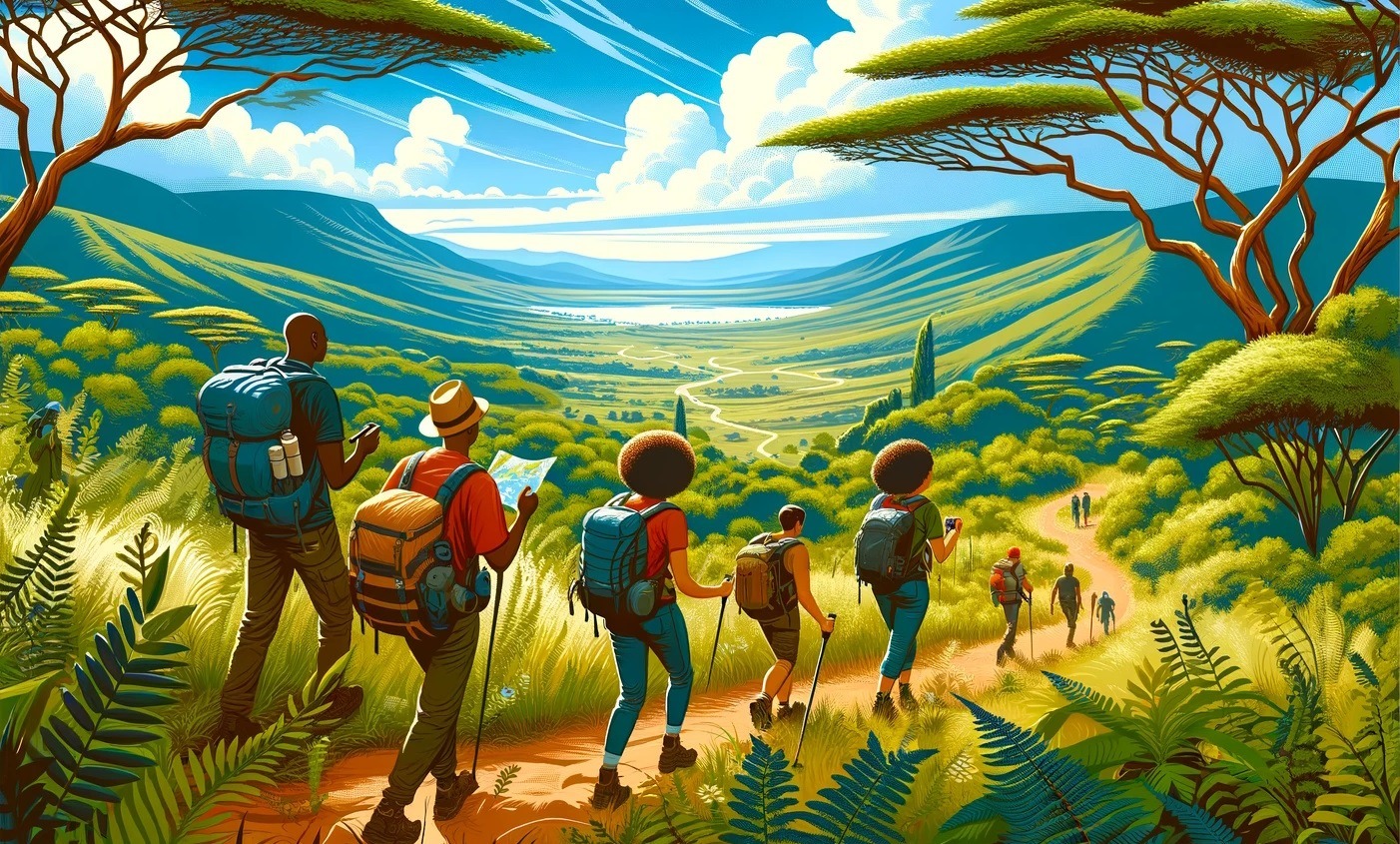The Ultimate Guide to Hiking Trails in Kenya
Hey there! Are you ready to hit the trails in Kenya? Here’s your ultimate guide to hiking trails in this beautiful country, with everything you need to know before hitting the trail. Let’s get started!
Must See Sights
Mount Kenya
This iconic peak is one of the most popular hikes in Africa, with several routes to choose from depending on your experience level and fitness. The summit trek takes around 5-7 days and requires a high level of fitness and mountaineering skills. But there are also shorter routes that offer stunning views of the glaciers and surrounding countryside.
Aberdare National Park
Located just outside Nairobi, this park offers several hiking trails ranging from easy to moderate difficulty levels. The most popular trail is the Karuru Falls hike, which takes around 3-4 hours and offers views of waterfalls and stunning forest scenery. Be sure to pack appropriate clothing and gear as temperatures can drop significantly at higher elevations.
Hell’s Gate National Park
This park is famous for its dramatic volcanic landscape, which makes for some unique hiking experiences. The main trail takes you through the park’s geothermal features and offers views of wildlife such as zebras and antelopes. Be sure to bring a hat and sunscreen as there is little shade on this trail.
Lake Nakuru National Park
Located in central Kenya, this park is famous for its flamingo population but also offers several hiking trails through the surrounding countryside. The Baboon Cliff hike takes you to a stunning viewpoint overlooking the lake and provides opportunities to spot wildlife such as buffaloes and rhinos.
Mount Longonot
This dormant volcano offers several hiking trails ranging from easy to challenging, with stunning views of Lake Naivasha and surrounding countryside. The summit trail takes around 3-4 hours and requires a moderate level of fitness, but the views are well worth it.
Remember to prepare properly before hitting the trail, including packing appropriate clothing and gear, letting someone know where you’re going, and carrying plenty of water. Also be aware of any potential safety risks such as wildlife or steep drops, and follow all park rules and regulations. Have a safe and memorable hike in Kenya!
Best Hiking Trails in Kenya
We have compiled a list of some of the top hiking trails in Kenya, including their location, difficulty level, terrain, and scenery. Read on to find the perfect trail for you!
Mt. Kenya Summit Trail
Aberdares Ranges Trekking Trails
Chyullu Hills Hiking Trails
These hills offer several hiking trails with stunning views of Nairobi National Park and the surrounding countryside. The most popular trail is the Ngong Hills hike, which takes around 2-3 hours and offers panoramic views of the area.
Kisii Hill Hiking Trails
Located in western Kenya, these hills offer several hiking trails with stunning views of the surrounding countryside. The main trail takes you to the summit of Kisii Hill and offers panoramic views of Lake Victoria and the surrounding area.
Hell’s Gate National Park Hiking Trails
Whether you’re a seasoned hiker or just starting out, safety should always be your top priority. Here are some essential tips to help you stay safe on the trail and prepare properly before embarking on your hike.
Safety and Preparation Tips
- Stay on designated trails and obey all park rules and regulations.
- Let someone know where you’re going, including your planned route and expected return time.
- Carry plenty of water and food, as well as any necessary medication or first aid supplies.
- Wear appropriate clothing and footwear, including sturdy hiking boots with ankle support and traction.
- Be aware of potential safety risks such as steep drops, loose rocks, and wildlife, and take necessary precautions.
- Stay within sight or sound of other hikers if possible, especially in remote areas.
- Watch out for changes in weather conditions and be prepared to alter your plans accordingly.
Equipment Tips
- Choose appropriate footwear that provides ankle support, traction, and protection from rough terrain.
- Wear comfortable, loose-fitting clothing made of breathable fabrics such as cotton or synthetic materials.
- Pack a lightweight backpack with enough space for all your gear, including water and food supplies.
- Carry a map and compass, as well as a GPS device if possible, to help you stay on track and find your way in case of an emergency.
- Include necessary tools such as a first aid kit, whistle, fire starter, and water purification tablets.
Food and Water Tips
- Drink plenty of water before, during, and after your hike to stay hydrated. A general rule of thumb is to drink at least 2-3 liters per day.
- Eat light meals before embarking on a long hike or one with significant elevation gain.
- Carry snacks such as energy bars, nuts, and dried fruit to keep your energy levels up during the hike.
- Avoid eating heavy or greasy foods before hiking, as they can cause discomfort or even nausea on the trail.
Remember that preparation is key when it comes to hiking safely and enjoying your experience in Kenya’s beautiful trails. Follow these tips, stay alert, and have a great time!

Before embarking on your hike in Kenya’s beautiful trails, it’s essential to have the right equipment to ensure a safe and comfortable journey. Here are some must-have items for your trip:
Equipment Checklist
- Tents, Sleeping Bags, Cooking Gear
- Four-season tent suitable for harsh weather conditions
- Comfortable sleeping bag with appropriate temperature rating
- Lightweight camp stove and fuel canisters
- Basic cooking utensils such as pots and pans
- Water bottles or hydration bladder
- Maps, Compasses, First Aid Kits
- Topographic map of the trail area
- Compass with basic navigation skills
- First aid kit with essentials such as bandages, antiseptic wipes, and pain relievers
Additional Items
- Waterproof bags or dry sacks for storage of equipment and clothing
- Headlamp or flashlight with extra batteries
- Windproof/water-resistant jacket and pants suitable for the weather conditions
- Sunscreen and insect repellent, as needed
Remember that having the right equipment can make all the difference in your hike, so be sure to check off everything on this list before setting out on your adventure. Happy hiking!
Tips for Hiking in Kenya
Permits and Fees
- Research the park(s) you plan to visit and check their websites for permit requirements and fees. Some parks require permits for entry, while others have a fee for day use or camping.
- Make sure to obtain any necessary permits before your trip.
Planning Your Hike
- Research trail conditions and difficulty levels to choose the right trail for your skill level and experience.
- Choose the right time of year based on weather conditions, wildlife activity, and crowds.
- Coordinate transportation and accommodations as needed, such as arranging for a shuttle or rental car, booking campsites or lodging, or planning public transportation options.
- Bring a map and compass, and know how to use them. Always let someone know your itinerary, including where you plan to hike and when you expect to return.
Safety First
- Be aware of wildlife in the area, and follow park rules and guidelines for interacting with animals. Never approach or feed wildlife, and always keep a safe distance.
- Stay on designated trails to avoid damaging sensitive ecosystems and to ensure your safety.
- Carry appropriate safety gear such as first aid kits, fire starters, and insect repellent.
- Be prepared for changing weather conditions, including extreme temperatures and precipitation.
By following these tips and planning ahead, you can have a safe and enjoyable hiking experience in Kenya’s beautiful trails.
Well there you have it – everything you need to know about hiking in Kenya’s beautiful trails. From equipment checklists and trail tips, to safety first and planning your hike, we covered it all. We hope this ultimate guide has inspired you to lace up those boots and hit the trails!
Remember to always plan ahead, research park rules and fees, and follow Leave No Trace principles to ensure a sustainable and enjoyable experience for everyone. And if you need more information or guidance, don’t hesitate to check out local tourism websites or contact a knowledgeable guide service.
Thanks for joining us on this journey!







